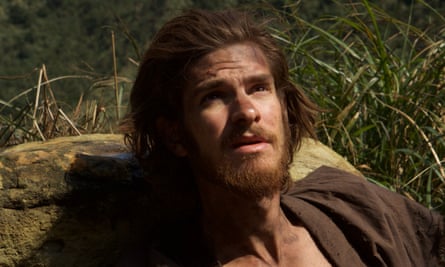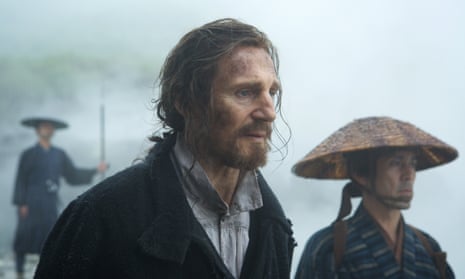The silence of God – or the deafness of man – is the theme of Martin Scorsese’s epic new film about an ordeal of belief and the mysterious, ambiguous heroism involved in humiliation and collaboration. It is about an apparent sacrifice in the service of the greater good, and a reckoning deferred to some unknowable future time. The possibility of reaching some kind of accommodation with the enemy, and not knowing if this is a disavowal of pride or a concession to the greatest sin of all, is a topic that Scorsese last touched upon in The Last Temptation of Christ in 1988, in which Jesus sees a future of peace and ordinary comfort.
Silence is a drama about Christian martyrdom, and like all such films, from Carl Dreyer’s The Passion of Joan of Arc to Fred Zinnemann’s A Man for All Seasons, it must address an atheist counter-sensibility aware that the Catholic Inquisition itself saw no difficulty in putting perceived heretics to death, and that arguably their own martyrs are therefore ineligible for lenient humanist sympathy. In fact, in this movie there is a fierce debate about the opposition of Christianity and Buddhism, of Europe and Asia, and about the relativism of faith.
Silence is not without flaws. Perhaps the casting of its stars, Andrew Garfield and Adam Driver, could have been reversed, to place more emphasis on Driver as the stronger performer, though Garfield’s boyish screen personality becomes haunted and complex. There is something a little broad about the moments in which a priest sees visions of Christ in himself. Yet with ambition and reach, and often a real dramatic grandeur, Scorsese’s film has addressed the imperial crisis of Christian evangelists with stamina, seriousness and a gusto comparable to David Lean’s.
The picture is adapted by Scorsese and screenwriter Jay Cocks from the celebrated 1966 novel Silence by the Japanese Catholic author Shūsaku Endō. It has in fact been filmed twice before, by Masahiro Shinoda in 1971 and João Mario Grilo as The Eyes of Asia in 1994.

In 17th-century Lisbon, two fiercely committed missionary priests, Rodrigues (Andrew Garfield) and Garrpe (Adam Driver), are told disturbing news by their confessor Valignano (Ciarán Hinds) concerning their much loved and admired mentor figure, Ferreira (Liam Neeson). Ferreira had journeyed to Japan many years before to challenge its brutal suppression of Christianity and to spread the word, but has now reportedly been forced to recant his faith under torture, and is living as a Buddhist with a Japanese wife and children. Astonished and outraged, the two young Jesuits refuse to believe it and demand to be allowed to travel to Japan to track him down and discover the truth.
Scorsese shows that their journey has something Conradian about it, and that Ferreira is a kind of Kurtz figure, albeit a Kurtz who has achieved nothing like a colonial kingdom. As the two men make their furtive landfall in Japan, they make tensely secret contact with fugitive believers who live in terror of being found out, and the priests entertain an orientalist stereotype of the supposed Japanese inscrutability: “Secrecy has made their faces into masks.”
Rodrigues and Garrpe seem like the proselytisers of the early Christian church, or even the apostles themselves. Driver’s gaunt and blazingly passionate face even makes him look a little like the traditional rendering of Jesus. But the examples of Judas the betrayer and Peter the denier are the ones that suggest themselves. Because everywhere, the authorities are crushing Christian communities, offering rewards for informers, and the priests’ mere presence brings their congregants into terrible danger. Suspected believers are ordered symbolically to trample a figure of Jesus underfoot: sometimes the inquisitor will be content with a relatively perfunctory step on the figure, but for more serious dissidents, spitting on the crucified Christ is needed. And there is the cruelty of torture and martyrdom: Christians can be lowered into a pit to bleed to death, or crucified in the surf for a quasi-drowning ordeal, or burned at the stake.
But Rodrigues is to come into contact with the sinuously calm, even almost charming Inquisitor Inoue and his interpreter (excellent performances from Issey Ogata and Tadanobu Asano), whose purpose is far more subtle: to show what torture looks like – rather as the Inquisition simply showed Galileo the instruments of cruelty – but then persuade the priest to renounce Christianity on rational grounds. Playing their strongest card, they produce poor, mortified Ferreira, who after years of threats and indoctrination has internalised his captors’ views, denying that the Catholic church was ever believed in that country, and claiming that the Japanese had simply followed a muddled, pantheistic sun-worship sect and mistook it for Christianity.
All the time, the priests are tormented by God’s silence, and the question of whether this is the same as absence, or if God’s refusal to intervene has become an unimaginable and intolerable cruelty. “How can I explain his silence to these people?” As the drama continues, the silence is broken for Rodrigues: but it is, ambiguously, a voice in his own head, giving him advice similar to that which he had himself given to cowering Japanese peasants early in the story.
Silence is a movie of great fervour that resolves itself into a single thought: if a believer is forced to recant, yet maintains a hidden impregnable core of secret faith, a hidden finger-cross, is that a defeat or not? God sees all, of course, including the way a public disavowal of faith has dissuaded hundreds or thousands from believing. Is the public theatre of faith more important than a secret bargain with a silent creator? It is a question kept on a knife-edge. Martin Scorsese’s powerful, emotional film takes its audience on a demanding journey with a great sadness at its end.

Comments (…)
Sign in or create your Guardian account to join the discussion